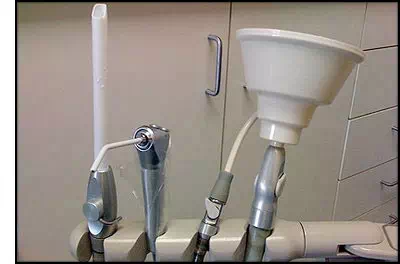
Dental Offices Wastewater
General
Overview of the Mercury Problem
Mercury from dental offices contributes significantly to the overall mercury contamination in wastewater. In 2008 EPA estimated that there were approximately 122,000 dental offices (approximately 160,000 dentists) that used or removed dental amalgam in the U.S., and that those offices discharged approximately 3.7 tons of mercury each year to POTWs. Dental offices were found in 2003 to have been the source of 50 percent of all mercury pollution entering POTWs.
Unless it is captured and removed at the dental office, mercury-containing amalgam waste will find its way into the environment when new fillings are placed or old mercury-containing fillings are drilled out and waste amalgam materials are flushed into chair-side drains. Some of the waste amalgam particles that reach the sewer system settle out in the sewers, and some are carried to POTWs. The physical processes used in POTWs remove about 90% of the mercury received in wastewater. The mercury removed from wastewater then resides in the biosolids or sewage sludge generated during primary and secondary treatment processes. The sludge generated by the water treatment process is sometimes incinerated, sometimes disposed of in solid waste landfills, and sometimes applied to agricultural land as fertilizer. In any case, mercury enters the environment. Also, a portion of the dissolved amalgam/mercury passes through the POTW and is discharged to surface waters where it can bioaccumulate in fish and shellfish.
Regulation
The collection, handling and disposal of dental amalgam was substantially affected by EPA pretreatment standards promulgated in 2017 (Effluent Limitations Guidelines and Standards for the Dental Category). This rule applies to offices where dentistry is practiced that discharge to a municipal sewage treatment plants known as publicly owned treatment works (POTWs). EPA finalized the technology-based pretreatment standards under the Clean Water Act to reduce discharges of mercury and other metals from dental offices into POTWs. Dental offices, which discharge mercury and other metals present in amalgam used for fillings, are the main source of mercury discharges to POTWs; these metals are subsequently released to the environment.
The rule requires dental offices to comply with requirements, which are based on practices recommended by the American Dental Association, including the use of amalgam separators. Once captured by the separator, dental amalgam can be recycled. Removing mercury when it is concentrated and easy to manage, such as through low-cost amalgam separators at dental offices (average annual cost per dental office is about $800), is a commonsense solution to managing mercury that would otherwise be released to air, land, and water.
The requirements for dental dischargers subject to the rule are detailed in the rule. Here, they are summarized:
- Ensure the removal of dental amalgam solids from all amalgam process wastewater via amalgam separator(s) or equivalent device(s) that meet the standard of the final rule.
- Implementation of two best management practices.
- Comply with reporting requirements.
- Maintain and make available for inspection certain records documenting compliance.
Dental dischargers (under any ownership) that were discharging into POTWs prior to July 14, 2017 ("existing sources"), must comply with the standards by July 14, 2020, and submit a one-time compliance report to a Control Authority certifying such by October 12, 2020. Dental dischargers whose first discharge to a POTW occurs after July 14, 2017 ("new sources") must comply with the standards immediately and submit a one-time compliance report certifying such within 90 days after first discharge to a POTW.
Your Control Authority is either a local wastewater utility, a state environmental agency, or a U.S. EPA regional office. For dental offices in Alabama, Connecticut, Mississippi, Nebraska or Vermont, your Control Authority is your state agency. For dental offices in all other states: contact your EPA regional office, your local wastewater utility, or your state agency Pretreatment Coordinator to find out who your Control Authority is. This EPA Pretreatment Contact List is a good starting point.
Concerning disposal of amalgam wastes, the best method is offsite recycling using a "mail away" licensed service. Acceptable waste generally includes waste dental amalgam, amalgam traps, amalgam separators filters, soft plastic amalgam traps, hard plastic amalgam traps with enclosed steel-wire mesh, teeth with amalgams or "wigglebugs," and encapsulated plastic pills. Most services provide 1-to-5-gallon kits for holding/shipping waste amalgam.
More Resources
Frequently Asked Questions on the Dental Office Category Rule (November 2017)
Sample Dental Office Compliance Report (docx) (November 2017). This compliance report is an example. Your Control Authority may have a different form. Contact your Control Authority to determine which form to use.



